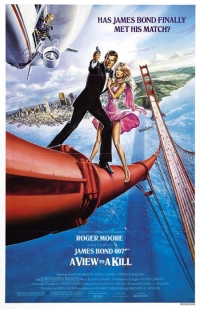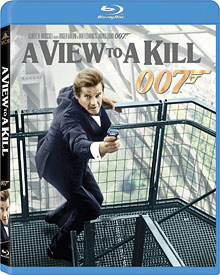Coate: In what way was Stacey Sutton (Tanya Roberts) a memorable Bond Girl?
Caplen: Stacey Sutton is, in many ways, another iteration of Jane Seymour’s Solitaire: an innocent woman who finds herself the unwitting participant in the villain’s scheme. But Stacey is neither a possession nor a pushover (thought she is gullible enough to believe Bond is reporter James Stock of the London Financial Times). She has a family legacy (and business) to protect, mounts a persistent legal battle against Zorin, and pursued a degree in geology so that she could take the helm of her family’s oil company. Stacey is career-driven and resolute: she refuses Zorin’s efforts to buy her silence and obtain dismissal of her lawsuit. Unlike Melina Havelock, revenge is not her motivation. She stands for principles. Unfortunately, Stacey has very little chemistry with Bond, leaving audiences with the impression that this career woman is cold, detached, and devoid of sexuality.
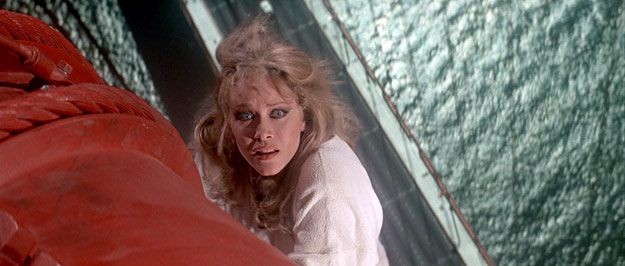
Cork: The absolute best moment in the film for Tanya Roberts is, for me, an ad-libbed reaction. When they were shooting Bond and Stacey arriving at the mine, they had her pull on miner’s overalls. Well, someone decided that Stacey would naturally be wearing over-sized men’s overalls. It is a natural assumption, but this is a Bond film. Stacey finding form-fitting miner’s overalls is no more absurd than Bond wearing a bone-dry white dinner jacket and bowtie beneath his waterproof suit in the opening of Goldfinger…. So the story goes that when presented with her costume, Roberts basically said, “you gotta be kidding me. No way am I going to be dressed like a sack of potatoes for a big hunk of this film.” I’m on Tanya’s side on this. She’s a Bond woman. She should not look like a moppet playing dress up. Of course, this happens the day they are shooting. Everything comes to a halt because Tanya does not want to wear the overalls. So they tailor up overalls for Tanya right there on location. Roger is not an actor who likes to wait around. He has little patience for actors who gum up the works. So they get the overalls snug in all the right places and come to shoot the moment when Bond walks out of the office with Tanya in her overalls. Cameras roll. Roger holds the door to the mining office open for her and in his most wicked tone simply says, “Pity you couldn’t find one that fits.” Tanya Roberts walks into the shot looking smoking hot, but she throws Roger this little glance that is so real and so honestly pissed off that my heart skips a beat every time I see it. That moment is like this little window into the Bond film I wanted to see…. Stacey is a piece of work. She was born rich, well-educated, has a good job, she’s beautiful, lives in a grand house, yet she’s single and fast going broke. Hands down, she wins my vote for “Bond woman most likely to end up as a crazy cat-lady.” She even has the only “get off my lawn” moment in a Bond film…. Somehow I feel like even after Zorin’s death, Stacey will lose it all, wandering the streets of San Francisco in faded glory like Cate Blanchett in Woody Allen’s Blue Jasmine. In films, there can be a perverse joy in seeing the pretty rich girl get screwed out of her unearned inheritance, which does not help us love Stacey…. But there is one more observation about Stacey. She has Blofeld’s cat. I was always entertained by the idea of a different version of the film where that was the tip-off that she was really the villain, that maybe Ernst Stavro was her grandfather who owned the oil company, that by acting dumb and obstinate, she had driven Zorin insane, that she was the one who wanted to destroy a city in some quest. Now, all this was just the fever dream of a Bond fan who thinks about these films way too much. I certainly never shared that thought with anyone at Eon. Then, lo and behold, we get The World Is Not Enough…about an oil heiress who, on a quest to get vengeance for something to do with her family’s oil fortune manipulates a disturbed man that is introduced as the villain into helping her attempt to destroy a city! Elektra King is the Stacey Sutton I always wanted!
Desowitz: The way she’s treated more paternally by Bond than a lover because there’s no sexual chemistry. It’s notable that they end the movie in a shower than in bed together.
McNess: With Zorin and Grace Jones’ May Day presenting such a vivid and offbeat portrayal of amorality, Stacey—in her genuineness and principled behavior—almost operates as a tonal balance. She’s obviously too timid and straightforwardly virtuous a character for some, but there is a strong element of decency and warmth in Tanya Robert’s performance that is welcome and memorable in the wider context of the film. The same goes for Patrick Macnee’s Tibbett in the film’s first half…. Stacey has often been admonished for failing to notice an airship sneaking up behind her, but this wasn’t an issue for me: deafened, dazed and confused from the previous blast, not to mention delighted and overcome by the sight of a man she thought surely dead, Stacey’s lapse certainly struck me as very reasonable! The action actually has a terrifically fun operatic quality: the lovers running towards each other while the airship steadily descends, with John Barry underscoring it all beautifully with a dramatic rendition of the romantic theme…. Interestingly, what also makes Stacey a memorable character is how Moore’s Bond responds to her. Moore is excellent; he brings a gently paternal quality to the fore (not an unwise decision given Moore’s advancing years) without ever slipping into the realm of patronizing. It’s a very fine line that Moore traverses with the greatest of ease. For instance, there’s a line where he’s lifting Stacey to safety—”Good girl, you’re nearly there”—a line that’s almost impossible to deliver without an air of condescension. But Moore never slips towards it.
Pfeiffer: I hate to be cruel, but Tanya Roberts is memorable only because she gave what is the worst performance of any Bond actress. It might have passed muster if she had been cast as an airhead, but a geologist??? I remember watching the advance screening and the audience would erupt in laughter every time she opened her mouth, especially when she’d cry out, “JAMES!” Cubby Broccoli’s usually infallible judgment in casting failed him this time. However, Tanya Roberts is a very nice person in real life. A few years after the film came out, I was on Geraldo Rivera with her and some of the other Bond girls. She was very sweet and likable.
Scivally: I really like Tanya Roberts. When we interviewed her for the Special Edition DVDs, she couldn’t have been nicer. That said, I think she gives a terrible performance in A View to a Kill. But I can’t put all the blame on her; in John Glen’s Bond films, you often have very accomplished actors giving the worst performances of their careers. Poor Tanya isn’t given much to work with. The first time we see her, she’s supposed to be despondent from selling out to Zorin. First impressions are important; it’s hard to bounce back from despondency—a note she’s still playing when we next see her—to sexiness, which is what we expect from a Bond woman. Once Bond shows up at her mansion, even he seems to realize that he’s too old, and she’s too emotionally fragile, for him to have a tryst with her. He sits up beside her bed, instead of climbing into it with her (admittedly, we have seen Bond in bed with May Day by this point, but in a lovemaking scene in which she immediately assumes the dominant position, effectively emasculating him). Stacey begins to cheer up by the film’s end, when she and Bond infiltrate Zorin’s mine, but then poor Ms. Roberts is saddled with some extraordinarily clunky exposition that there’s simply no good way to deliver, further undermining her performance. It’s an underwritten part to begin with, and with John Glen’s direction, or lack thereof, an under-acted one as well. Roberts deserved better.
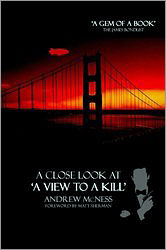 Coate: Andrew, what was the objective with your book, A Close Look at ‘A View to a Kill’?
Coate: Andrew, what was the objective with your book, A Close Look at ‘A View to a Kill’?
McNess: The principal objective was to focus on how the film plays with the series’ formulaic elements in a range of understated yet absorbing ways. Usually the variations on the formula in any given Bond film are clear-cut and apparent; A View to a Kill, by contrast, often achieves its effects in more elusive ways. Straight up, the film is blatantly formulaic—another madman intent on controlling a market—but in its finer details, it’s something else. I couldn’t always put my finger on the various appeals of A View to a Kill. This book constitutes the subsequent investigation! Implicitly, of course, the book also celebrates the cinematic James Bond formula—and implicit with that, its literary foundations.
Coate: What is the legacy of A View to a Kill?
Caplen: A View to a Kill certainly whets audiences’ appetites for the gravitas Timothy Dalton brought to the role of James Bond. But the film is more than a bridge between Octopussy and The Living Daylights—it offers respectful closure to the Moore chapter, which, we must remember, began with no less absurdity. (Moore’s first mission as James Bond involved the taking of a tarot card reader’s virginity in voodoo land.)
Cork: I think its greatest claim to fame is as being Roger Moore’s last turn as Bond and as the Bond film with one of the most successful title songs in the series. The BASE jump off the Eiffel Tower will always be iconic, as will the fight atop the Golden Gate Bridge…. There’s an interesting legacy to the title song. It marked the end of Duran Duran. They were the biggest group going. The song went number 1 in the US on July 13th, 1985, the same day Duran Duran performed it at Live Aid. Not that anyone cared, but Simon Le Bon hit a memorably bad note during the performance that haunted him for years. That concert would mark the last time the original members of the group would perform together for over fifteen years…. Trivia question answer: Considering the iconic nature of California Girls, Bond beat the Beach Boys (or Gidea Park, the band heard in the film). In 1965, the original California Girls only hit number 3 on the Billboard Hot 100 chart…. The film itself, mostly, I think, serves as a warning sign for the filmmakers. No one wants to make a Bond film less-loved than A View to a Kill. It is the Bond film that feels most complacent, most like no one really broke a sweat while making it. That’s completely untrue, of course. It was a very difficult film to make in many regards. Yet, I think most involved would look back on it and regard it as a project that never quite jelled. I think when anyone is working on a new Bond film and the creative juices are not flowing, the hour is late, the bones are tired, one of the reasons they keep going, pushing themselves to do better is because A View to a Kill is there to remind them that when it comes to Bond, only the extraordinary will do.
Desowitz: Again, the legacy is Moore’s final outing, full of grace if awkwardly looking out of place tangling with Walken and Jones.
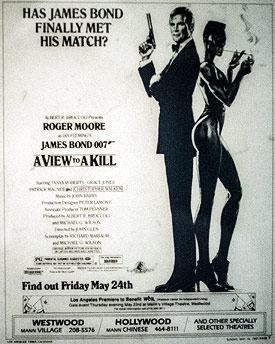 McNess: It’s the ultimate Eighties rendering of the James Bond universe, what with its corporate super-villain, insanely strong henchwoman, Duran Duran song, tougher edge to the action, Cold War complexity, and so on. And yet its qualities are not trapped within the decade. Furthermore, A View to a Kill demonstrated that a foreboding, nihilistic edge could be threaded through a Bondian romp. It reinforced, also, how some especially creative casting of the villainy could supply a formula flick with an unexpectedly distinct flavor. Last but not least, the film reminds us—I think better than any other Bond film to date—that rewarding variations on the formula need not always be especially obvious.
McNess: It’s the ultimate Eighties rendering of the James Bond universe, what with its corporate super-villain, insanely strong henchwoman, Duran Duran song, tougher edge to the action, Cold War complexity, and so on. And yet its qualities are not trapped within the decade. Furthermore, A View to a Kill demonstrated that a foreboding, nihilistic edge could be threaded through a Bondian romp. It reinforced, also, how some especially creative casting of the villainy could supply a formula flick with an unexpectedly distinct flavor. Last but not least, the film reminds us—I think better than any other Bond film to date—that rewarding variations on the formula need not always be especially obvious.
Pfeiffer: If A View to a Kill has a legacy, it’s that it was Roger Moore’s final Bond film. By all accounts, he probably went one movie too far. I know Roger agrees with that. He felt the age difference between him and Roberts was too distracting. He had originally quit after Octopussy and negotiations between him and Broccoli, who he liked immensely, became strained. I think Roger would have preferred to have left well enough alone with Octopussy. Yet, A View to a Kill obviously has a major following even today. One of Cinema Retro’s writers, Hank Reineke, recently covered a rare big screen showing of the movie at the Nitehawk Cinema in Brooklyn. He was astonished that it had sold out quickly and that the audience was so appreciative of the movie. (Click here to read coverage.) So vintage Bond flicks seem to have a great shelf life—even the weakest ones.
Scivally: Seeing what happens to Tibbett and Chuck Lee, the lesson of A View to a Kill is: always look in the back seat before getting into your damn vehicle! Seriously, what is the film’s legacy? I think it will be remembered as the last Bond film for Roger Moore, Lois Maxwell and stuntman Bob Simmons, and for the Duran Duran title song, and little else.
Coate: Thank you, everyone, for participating and for sharing your thoughts about A View to a Kill on the occasion of its 30th anniversary.
The James Bond roundtable discussion will return in Remembering “GoldenEye” on its 20th Anniversary.
---END---
SPECIAL THANKS:
John Hazelton, Vince Young.
- Michael Coate


